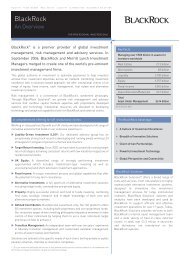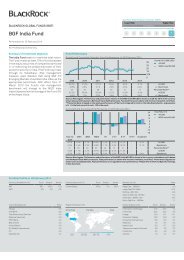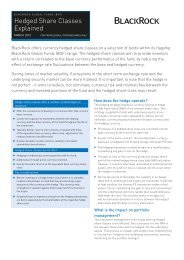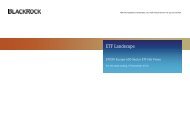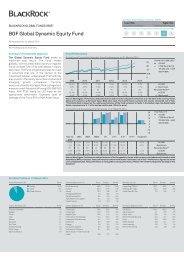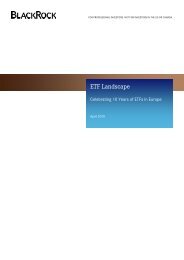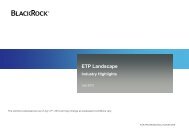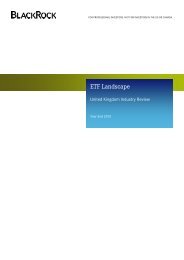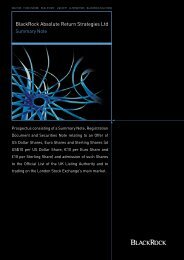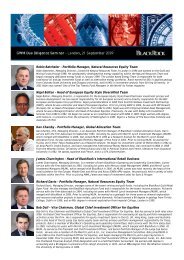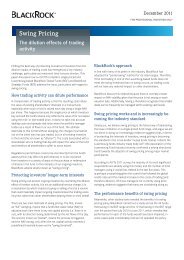Outlook for Global Wholesale and Investment Banking - BlackRock ...
Outlook for Global Wholesale and Investment Banking - BlackRock ...
Outlook for Global Wholesale and Investment Banking - BlackRock ...
You also want an ePaper? Increase the reach of your titles
YUMPU automatically turns print PDFs into web optimized ePapers that Google loves.
March 16, 2010Banks5) Funding – driving a dramatic rethinking of portfolios, with regulationthe swing factorFunding has already driven a major review of the industryportfolio, <strong>and</strong> we think funding constraints will remain criticalto business choices, particularly as stable funding ratio targetskick in. Against this backdrop, the critical drivers <strong>for</strong> theinvestment banks <strong>and</strong>, we think, key issues <strong>for</strong> policymakersare: 1. whether or not securitisation resumes; <strong>and</strong> 2. theflexibility given to banks to per<strong>for</strong>m maturity trans<strong>for</strong>mation.One of most fundamental shifts resulting from the liquiditycrisis is an ongoing rethinking of the businesses, shapedaround the quality of collateral generated, especially given theongoing cost of wholesale funding. Today, there are threeclusters of funding markets (see Exhibit 20):securities that can be pledged to central banks;other good quality collateral that can be funded(e.g. equities in Europe that are pledgable in the US); <strong>and</strong>those that require unsecured funding.The cost <strong>and</strong> scarcity of unsecured funding has alreadydriven banks to shrink units that are heavy consumers ofunsecured funds – such as warehousing, non-investmentgrade, prop, illiquid fixed income, some prime brokerage. Ithas also significantly amplified the shift to liquid flow markets.On the other h<strong>and</strong>, businesses such as flow rates, FX, cashequities, <strong>and</strong> flow derivatives have been re-emphasised in thebusiness portfolio.Impending regulatory change will rein<strong>for</strong>ce these trendsover the coming three years. Morgan Stanley haselsewhere estimated the net stable funding ratio <strong>for</strong> theEuropean banks sector at large at about 87%, implying afunding gap of approximately €1.5 trillion in Europe, ontoday’s accounts. This is a dramatic gap, <strong>and</strong> there is a widedispersion in the health of the banks operating in this sectoraround the net stable funding ratio. Given the scarcity <strong>and</strong>costs of matched funding <strong>for</strong> both well funded <strong>and</strong> less wellfunded banks, there will be tremendous scrutiny applied tohow scarce unsecured term funding is deployed. This is likelyto continue to drive a reshaping of the industry portfolio <strong>and</strong>the competitive l<strong>and</strong>scape around four segments ofbusinesses (Exhibit 21).• Low Return on Asset (ROA), high asset intensitybusinesses which are largely self-funded throughaccess to the repo market. This is primarily PrimeBrokerage, but also includes some niche such as FundLinked. Firms without pressure on leverage ratio <strong>and</strong>balance sheet size (which may be a null set) could takeoutsized share of the rebound in hedge fund dem<strong>and</strong>;others (most) will be highly selective on fund financing.• Medium ROA business which are net consumers ofunsecured funding, such as fixed income, warehousing,illiquids. Only those with strong access to a diversity offunding sources across the term structure are able tocompete here at the moment, <strong>and</strong> there are veryattractive opportunities available <strong>for</strong> these firms.• High ROA, medium ROE, low funding dem<strong>and</strong>businesses such as structured rates, structured equity,structured FX. These are attractive from a fundingperspective, but are effectively pushing banks higher upthe risk-return curve in search of funding-free returns.While most firms have run to the flow side of the boat, afew firms will continue to reap an outsized share of theFIG restructuring <strong>and</strong> long-dated ALM business, inparticular.• High ROA, medium or low funding dem<strong>and</strong>: Flowrates, FX, cash equities, <strong>and</strong> flow derivatives. These areall highly attractive to all banks, <strong>and</strong> a key driver of theflow monster strategy. Note, however, that it is difficult todeliver alpha growth in these businesses; as a result,somewhat ironically, risk taking is becoming a biggerfeature in all of these markets.Sovereign risk remains a key risk to funding. Assuming thisstabilizes, over the medium to long term, deposit gathering<strong>and</strong> terming out debt may help. Put another way, banks willwant to rethink their funding model so they have the capacityto enjoy higher-margin businesses that need unsecuredfunding. Deposit gathering, expansion of transaction bankingbusinesses, regulatory impact of inclusion or exclusion ofcorporate deposits, re-intermediation of money market fundsin retail deposit gathering strategies will all be key drivers ofsuccess at the industry <strong>and</strong> firm level.19



